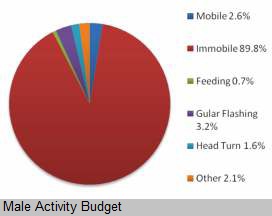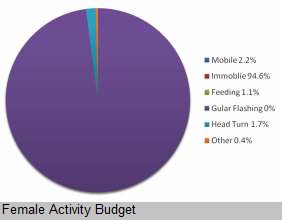Any and all opinions expressed in
this newsletter are solely those of the author(s) and do not reflect the opinion of ATREE.
Centre for Excellence
in Conservation Science
Royal Enclave,Srirampura,Jakkur
Post
Bangalore-560064
Telephone: 080-23635555 (EPABX)
Fax : 080- 23530070
I started my study on the fan throated lizard (Sitana
ponticeriana) with a goal to
generate base line information on
the species, with a particular
focus on its home range,
utilization of habitat, dependence
of plant species within the habitat
and time activity budgets
additionally focusing set on the
variation between the sexes.
I conducted the study between
the months August and October
at the scrublands around the
Agasthyamalai Community-
Based Conservation Centre in Manimutharu.
Being the mating season the males and
females could be easily distinguished due to
the display of colored dewlap of the male as
seen in the picture.
With the help of Chian and many others
(unsuspectingly roped into aiding me), we
managed to create a net and captured 21
individuals from three different sites around
the station. This was not an easy task as the Sitanas can be quite fast and their habitat
makes it easy for them to escape the clutches
of our net! All 21 individuals were measured
and weighed. Furthermore 12 (6 male and 6
female) were attached with a radio tag and
tracked between 14- 25 days.
Results showed females were on average 4
cm from snout to vent, tail length 10 cm and
weighed 3.42 gm, whilst the males proved to
be larger at 5.22 cm from snout to vent, 12.1
cm in tail length and weighing 5.4 gm on
average. Although home ranges
for both sexes were small, the
males proved to have a much
larger home range than the
females. The preferred habitat
was in the vicinity of low thorny
shrubs mainly Catunare
gumspionsa and Dalbergia
coromandel ina but al so
amongst Dodonae aviscosa in
which they used the leaf litter for
cover.
Alongside this activity budgets
were made for monitoring behavior. A total of
240 scans of 5 mins were taken throughout
the day at different time intervals. A set of
behaviors: mobile, immoblile, feeding, gular
flashing (for males), head turning and “other”
were selected. Although both sexes proved
to spend the majority of the day immobile, the
males showed to have more activity due to
their displaying action results for both sexes
can be seen in pie chart.
This current study took place prior to the
monsoon. In the future it could be interesting
to see of behaviour and home ranges change
after the breeding season and rains as well as
to monitor the behaviours of the juveniles.
Editorial
Team
Editor: Allwin
Jesudasan
Associate editor: Rajkamal
Goswami
Editorial Review: R.
Ganesan, M. Soubadra Devy, T. Ganesh
Design and presentation:
Kiran Salagame
A S H O K A T R U S T F
O R R E S E A R C H I N E C O L O G Y A N
D T H E E
N V I R O N M E N T
Research Highlights
Ecology of Sitana ponticeriana
- Michelle Logan
oganmich@gmail.com
If you have any suggestions or comments
please let us know through the boxes below







